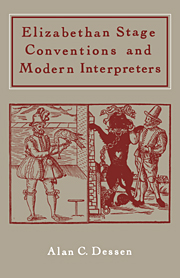Book contents
- Frontmatter
- Contents
- Preface
- Note on texts and old spelling
- 1 The arrow in Nessus: Elizabethan clues and modern detectives
- 2 Interpreting stage directions
- 3 The logic of ‘this’ on the open stage
- 4 Elizabethan darkness and modern lighting
- 5 The logic of ‘place’ and locale
- 6 The logic of stage violence
- 7 Theatrical metaphor: seeing and not-seeing
- 8 Conclusion: Elizabethan playscripts and modern interpreters
- Notes
- List of plays and editions
- Index
5 - The logic of ‘place’ and locale
Published online by Cambridge University Press: 22 September 2009
- Frontmatter
- Contents
- Preface
- Note on texts and old spelling
- 1 The arrow in Nessus: Elizabethan clues and modern detectives
- 2 Interpreting stage directions
- 3 The logic of ‘this’ on the open stage
- 4 Elizabethan darkness and modern lighting
- 5 The logic of ‘place’ and locale
- 6 The logic of stage violence
- 7 Theatrical metaphor: seeing and not-seeing
- 8 Conclusion: Elizabethan playscripts and modern interpreters
- Notes
- List of plays and editions
- Index
Summary
O, this is to be imagin'd the Counter belike?
(Every Man Out of His Humour, l. 4246)If theatrical professionals have used a later technology to impose a verisimilar stage night upon imaginary darkness, for an even longer period editors have imposed upon many, most, or all Elizabethan scenes a later sense of ‘place’ or locale. Behind this insertion of information not in the original texts or scripts lies a long and hallowed tradition dating back to the eighteenth century. Thus, in the Preface to his highly influential edition of Shakespeare, Edmund Malone wrote that his reader will ‘be pleased to find the place in which every scene is supposed to pass, precisely ascertained: a species of information, for which, though it often throws light on the dialogue, we look in vain in the ancient copies, and which has been too much neglected by the modern editors.’ Malone (like several editors before him) therefore supplied what he felt had too long been neglected, and, until quite recently, most editors have followed his example, even when the dramatist has provided no clear signals. As a result, many of the texts widely used by actors, directors, and critics give prominent typographical position to such locales as ‘a wood’ or ‘a room in the castle,’ designations that have no authority other than the theatrical or literary tastes of an early editor.
- Type
- Chapter
- Information
- Elizabethan Stage Conventions and Modern Interpreters , pp. 84 - 104Publisher: Cambridge University PressPrint publication year: 1984



